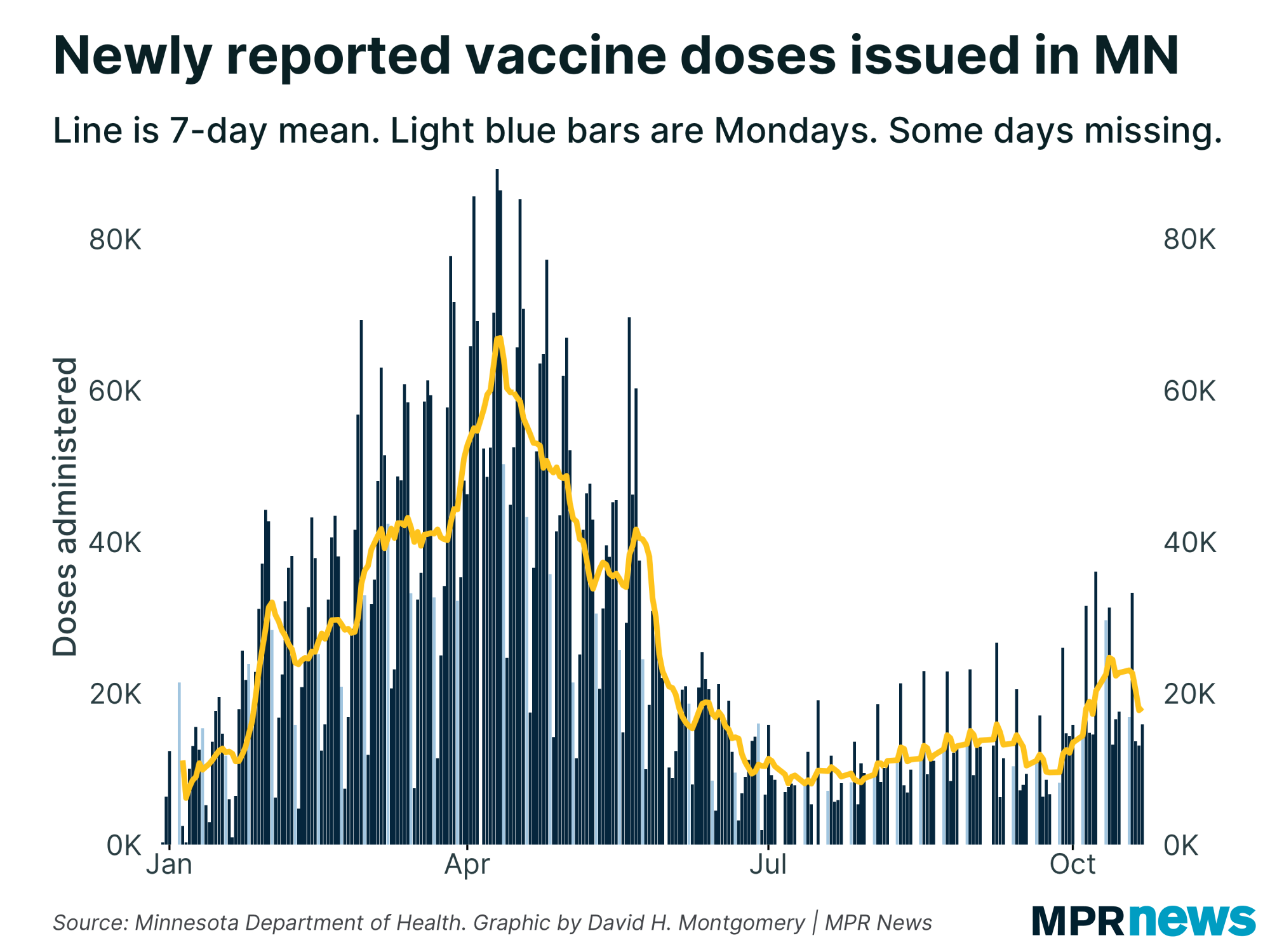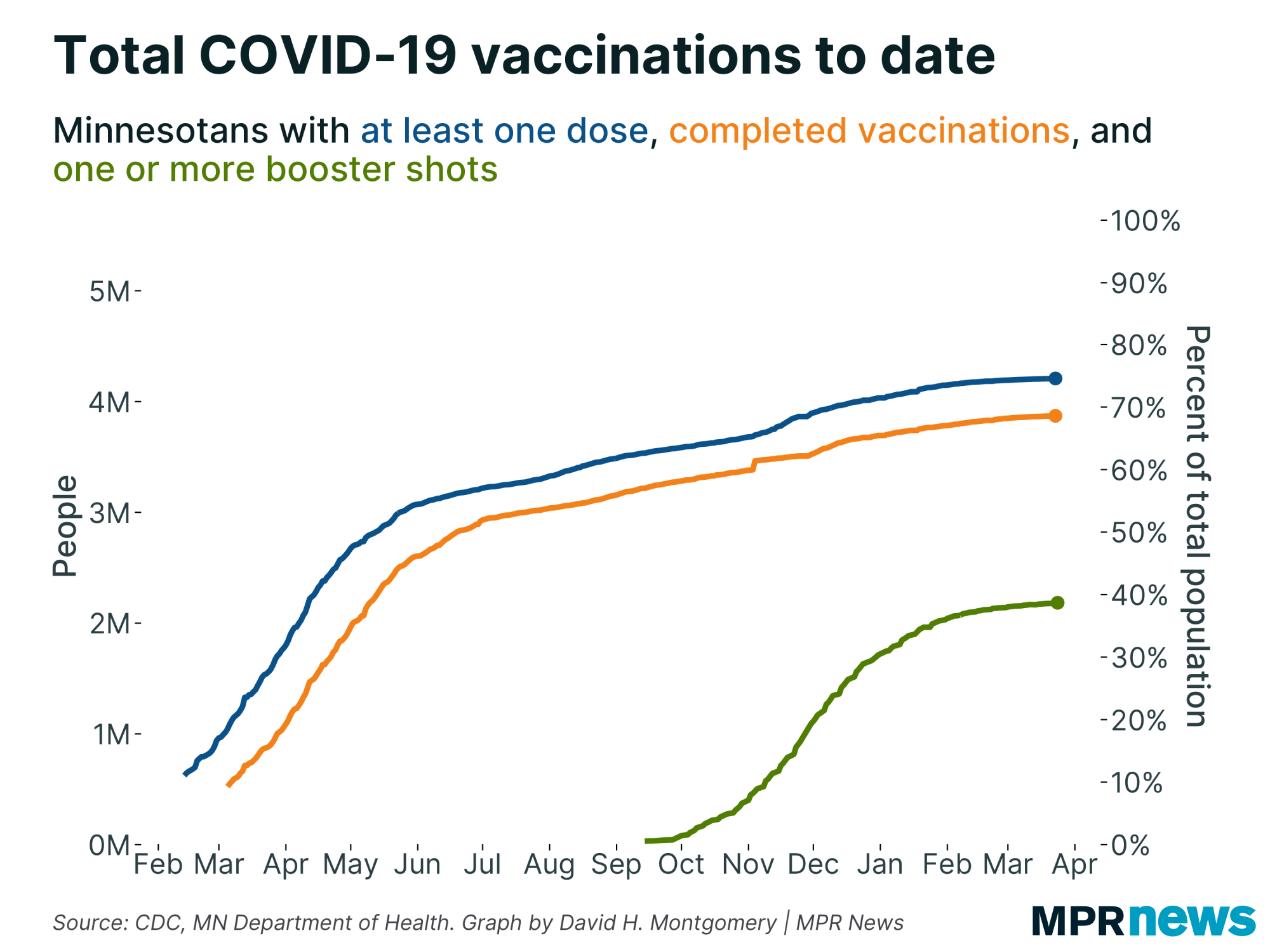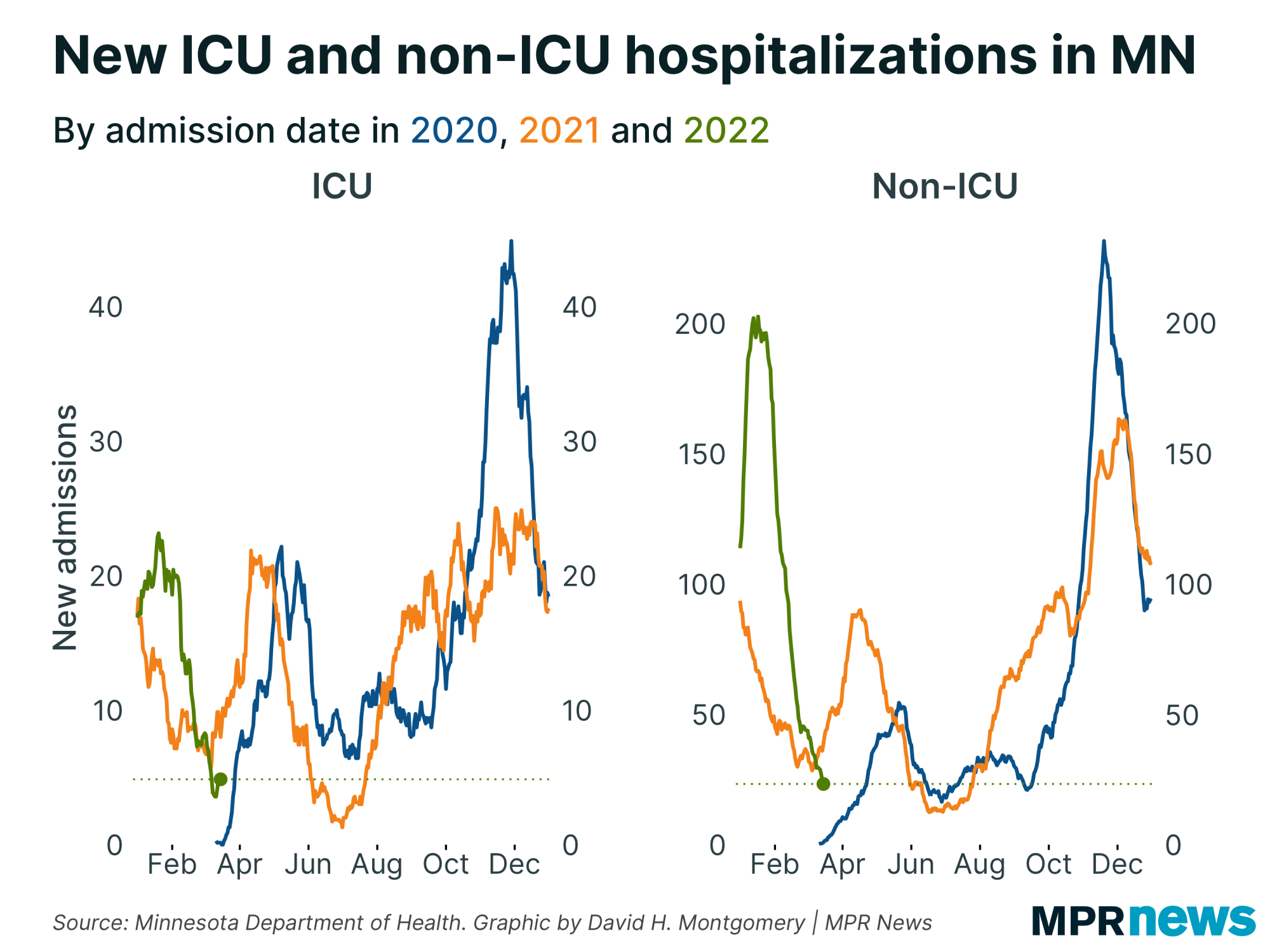Latest on COVID-19 in MN: Vaccinations rebound; pandemic trends steady

Go Deeper.
Create an account or log in to save stories.
Like this?
Thanks for liking this story! We have added it to a list of your favorite stories.
3 things to know:
Vaccination pace improves; weather may change that
Uptick in active cases but trends still good
Overall pandemic metrics look encouraging
Updated 5:45 p.m.
After falling and then flattening following a late January surge, Minnesota’s COVID-19 vaccination counts are starting to rebound as overall pandemic trends remain encouraging.
The state Health Department on Friday reported about 40,000 new vaccinations, a significant jump that helped push the seven-day average to levels seen in early February. Officials noted that Minnesota’s now put more than 1 million COVID-19 doses into arms.
About 13.1 percent of Minnesotans had received at least one dose as of Wednesday, with about 5.2 percent completely vaccinated. Roughly 39 percent of Minnesotans 65 and older have received at least one shot.

State public health leaders have emphasized over the past weeks that the relatively low flow of vaccine supplies from the federal government is the main problem holding back the pace of vaccinations.
Turn Up Your Support
MPR News helps you turn down the noise and build shared understanding. Turn up your support for this public resource and keep trusted journalism accessible to all.
Despite Friday’s rebounding vaccination numbers, the Health Department this week warned the cold snap gripping the nation will delay vaccine shipments to Minnesota, potentially depressing vaccination counts in the short-term.

The department said about half of the 85,000 or so doses expected this week will not arrive in time as expected. The state has already postponed appointments at two community vaccination sites set for Thursday and Friday.
While Friday’s vaccination numbers were positive, Minnesota at the current pace would only be able to vaccinate about 80 percent of adults by sometime in September. Getting it done by summer would require the state to administer 40,000 to 50,000 shots per day, or more.
Minnesota’s currently ranked 20th among states in doses administered per 100,000 people, according to data collected by the federal Centers for Disease Control and Prevention.

Vaccination questions aside, Minnesota’s COVID-19 numbers show the state on a steady, positive path, with key pandemic metrics continuing to improve. Known, active cases ticked above 7,000, but the overall trend is solid, hovering around late September levels.

The seven-day hospital admissions trend for people with COVID-19 has also receded to September levels.
There were 282 people with COVID-19 in Minnesota hospitals as of Thursday. It was a second consecutive day of hospitalizations below 300, the first time that’s happened since the fall; 59 people needed intensive care.

Eight reported deaths on Friday raised Minnesota’s toll to 6,412. Among those who’ve died, about 63 percent had been living in long-term care or assisted living facilities; most had underlying health problems.

The seven-day rolling average for deaths is down to 7 deaths per day, the lowest since September.
The state’s recorded 477,287 total confirmed or probable cases so far in the pandemic, including 1,001 reported Friday. About 97 percent of Minnesotans known to be infected with COVID-19 in the pandemic have recovered to the point they no longer need to be isolated.

The trends offer reasons to feel encouraged, enough so that Gov. Tim Walz on Wednesday proclaimed “we’re on our way to ending the pandemic” as he OK’d reopening secondary schools, starting Monday. “We’re beating this thing.”
State health officials continue to monitor new virus strains circulating in the United States, which may be more contagious. Walz and other officials have warned that they could lead to an increase in cases.
Kris Ehresmann, the state’s infectious disease director, reaffirmed those concerns on Tuesday, noting that Minnesota’s now confirmed 40 cases of the U.K. strain here. “We want to make sure we’re not giving a foothold to these variants.”
Michael Osterholm, director of the Center for Infectious Disease Research and Policy at the University of Minnesota, told MPR News on Thursday that the variants are very concerning and it’s unclear whether they evade immunity from vaccination or natural protection.
Cases spread across age groups, regions
People in their 20s still make up the age bracket with the state’s largest number of confirmed cases — more than 90,000 since the pandemic began, including more than 47,000 among people ages 20 to 24.

The number of high school-age youth confirmed with the disease has also grown, with more than 37,000 total cases among those ages 15 to 19 since the pandemic began.
Although less likely to feel the worst effects of the disease and end up hospitalized, experts worry youth and young adults will spread it unknowingly to older relatives and members of other vulnerable populations.
People can have the coronavirus and spread COVID-19 when they don’t have symptoms.
Regionally, most parts of Minnesota are down significantly from the late November, early December spike as well as a January blip.
There has been an uptick in cases in northwestern Minnesota recently, though it’s unclear why just yet.

Caseloads still heaviest among people of color
In Minnesota and across the country, COVID-19 has hit communities of color disproportionately hard in both cases and deaths. That’s been especially true for Minnesotans of Hispanic descent for much of the pandemic.

Even as new case counts continue to fall from their late November, early December peaks, the data shows Latino people continue to be hit hard.
Distrust of the government, together with deeply rooted health and economic disparities, have hampered efforts to boost testing among communities of color, officials say, especially among unauthorized immigrants who fear their personal information may be used to deport them.
Last week, Minnesota Health Commissioner Jan Malcolm acknowledged the need to ensure that vaccination opportunities be spread equitably.
Malcolm said the state will release data soon regarding vaccinations, race and ethnicity. Officials say they’re trying to improve the quality of data. Per state law, it's been shared voluntarily, and so may be inconsistent.
COVID-19 in Minnesota
Data in these graphs are based on the Minnesota Department of Health's cumulative totals released at 11 a.m. daily. You can find more detailed statistics on COVID-19 at the Health Department website.
Developments from around the state
Minneapolis lifts bar counter restrictions
The city of Minneapolis has lifted its ban on bar counter seating just in time for the weekend.
Minneapolis Mayor Jacob Frey said the decision was based on public health data, showing a decrease in COVID-19 cases in the city.
Bars in the city must still require reservations, social distancing and no more than two customers can be seated together at a bar counter.
Establishments also have to lower music volume to keep patrons from talking loudly and sitting too close together.
Last week, citing vaccine progress in the state, Gov. Tim Walz loosened some pandemic-related regulations that allow bars to be open one hour longer, until 11 p.m.
— Nina Moini | MPR News
Top headlines
Collaboration between White Earth Nation, Mahnomen Co. leads to one of highest vaccination rates in MN: Since Minnesota began distributing coronavirus vaccines late last year, Mahnomen County in northwestern Minnesota has consistently led the pack.
Michael Osterholm on how new COVID variants could change the pandemic's trajectory: As vaccinations continue, new variants of the virus are spreading. Scientists worry that the vaccine could be less effective against these mutations and that infection rates might rise again if one of these variants becomes the dominant strain.
New vaccine tool will tell Minnesotans when they can get COVID-19 shots: The tool will alert Minnesotans of their eligibility, connect them to resources to schedule an appointment and provide information on nearby vaccination opportunities. Minnesotans will still have to make their own appointment to get a shot through a vaccine provider.
For Ramsey County homeless, hotel rooms offer safe haven and hope amid the pandemic: Ramsey County officials say they have space for anyone experiencing homelessness to stay indoors. But the fallout from the pandemic is complicating the county's response.



